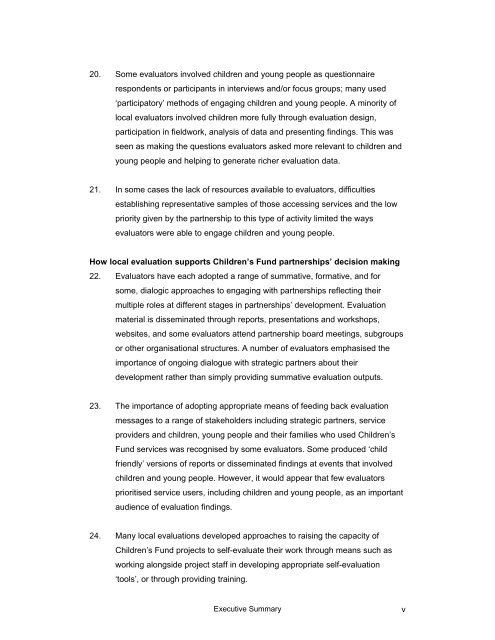Local Evaluation of Children's Services Learning from the Children's ...
Local Evaluation of Children's Services Learning from the Children's ...
Local Evaluation of Children's Services Learning from the Children's ...
- No tags were found...
Create successful ePaper yourself
Turn your PDF publications into a flip-book with our unique Google optimized e-Paper software.
20. Some evaluators involved children and young people as questionnairerespondents or participants in interviews and/or focus groups; many used‘participatory’ methods <strong>of</strong> engaging children and young people. A minority <strong>of</strong>local evaluators involved children more fully through evaluation design,participation in fieldwork, analysis <strong>of</strong> data and presenting findings. This wasseen as making <strong>the</strong> questions evaluators asked more relevant to children andyoung people and helping to generate richer evaluation data.21. In some cases <strong>the</strong> lack <strong>of</strong> resources available to evaluators, difficultiesestablishing representative samples <strong>of</strong> those accessing services and <strong>the</strong> lowpriority given by <strong>the</strong> partnership to this type <strong>of</strong> activity limited <strong>the</strong> waysevaluators were able to engage children and young people.How local evaluation supports Children’s Fund partnerships’ decision making22. Evaluators have each adopted a range <strong>of</strong> summative, formative, and forsome, dialogic approaches to engaging with partnerships reflecting <strong>the</strong>irmultiple roles at different stages in partnerships’ development. <strong>Evaluation</strong>material is disseminated through reports, presentations and workshops,websites, and some evaluators attend partnership board meetings, subgroupsor o<strong>the</strong>r organisational structures. A number <strong>of</strong> evaluators emphasised <strong>the</strong>importance <strong>of</strong> ongoing dialogue with strategic partners about <strong>the</strong>irdevelopment ra<strong>the</strong>r than simply providing summative evaluation outputs.23. The importance <strong>of</strong> adopting appropriate means <strong>of</strong> feeding back evaluationmessages to a range <strong>of</strong> stakeholders including strategic partners, serviceproviders and children, young people and <strong>the</strong>ir families who used Children’sFund services was recognised by some evaluators. Some produced ‘childfriendly’ versions <strong>of</strong> reports or disseminated findings at events that involvedchildren and young people. However, it would appear that few evaluatorsprioritised service users, including children and young people, as an importantaudience <strong>of</strong> evaluation findings.24. Many local evaluations developed approaches to raising <strong>the</strong> capacity <strong>of</strong>Children’s Fund projects to self-evaluate <strong>the</strong>ir work through means such asworking alongside project staff in developing appropriate self-evaluation‘tools’, or through providing training.Executive Summaryv
















